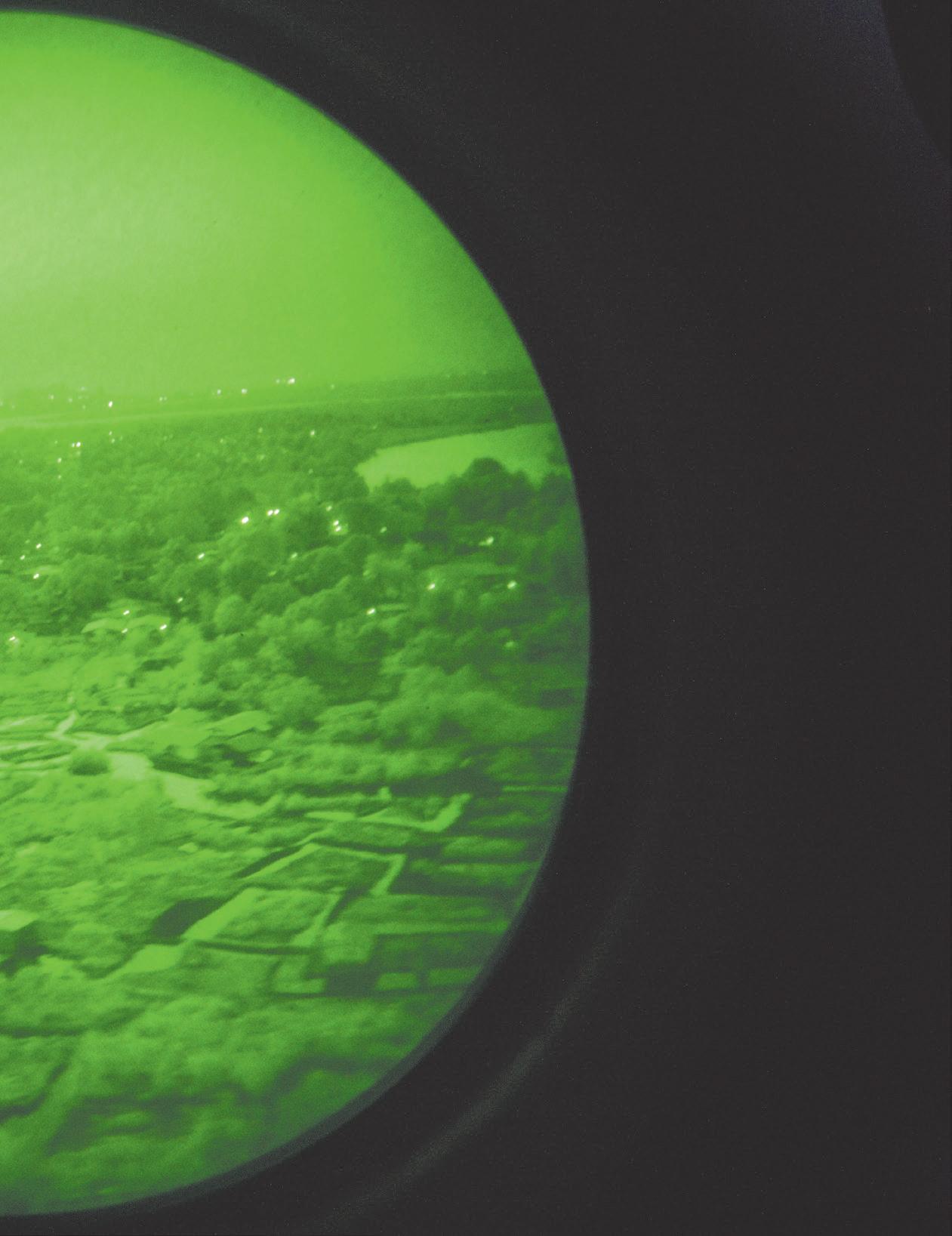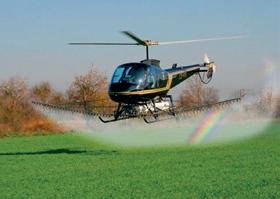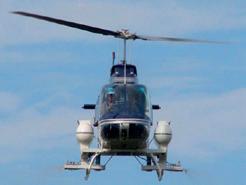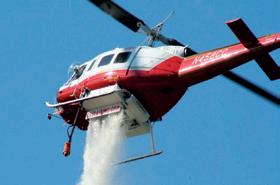
9 minute read
Night Aerial Firefighting Taking the Fight 24/7
by Ryan Mason

Aerial firefighting operations during a wildfire typically run from sunrise to sunset. That is the way aerial firefighting has been conducted since aircraft were first employed in the battle against wildfires – until recently.

Night aerial firefighting has seen multiple successful helicopter-based night trials over the last several years. Coulson Aviation held trials with the S-61 in Ballarat, Victoria, Australia in 2018, then again in 2019 in Orange County, California. Deploying the S-61 and S-76 again during the 2019-2020 Australian fire season. More recently, Kachina Aviation also conducted helicopter based night aerial firefighting trials in the United States and Mc Dermott Aviation entered the arena in 2018 and during the 2019/2020 Australian bushfire season. These efforts by several industry leaders in the helicopter sector of aerial firefighting proving that night aerial firefighting has become not only possible but proven safe through extensive testing in several continents.
Night aerial firefighting has not however been confined to just rotary operations. Fixed wing operators like Colorado’s CoFire Aviation (see our cover story in the Jan/Feb issue of AerialFire) have been at the forefront of developing a program to bring night SEAT operations into the nighttime firefighting arena.
CoFire began conducting testing in 2018 in cooperation with the Oregon Department of Forestry to demonstrate the functionality of SEAT aircraft performing in the same Capacity.
CoFire Aviation co-founders Chris Doyle and Kyle Scott first began investigating the possibility of conducting night firefighting operations back in 2010, although shelving the idea initially due to a lack of skilled pilots possessing enough relevant experience in low altitude operations under Night Vision Goggles. Several years after their initial discussions on the subject however, the CoFire team was able to make good on their initial goal, proving the concept and practical application during operational field testing in the summer of 2018 in Oregon.
Marc “Thor” Olson heads up the company’s NVG based operations. Olson was tasked to come up with a plan to demonstrate that ability to some of the company’s customers that included designing an intensive training program and selecting the latest technology to aid mission safety.
After several months of training pilots to a level that satisfied internal company safety standards, CoFire turned to Aviation Specialties Unlimited (ASU) for the latest in night vision technology - White Phosphor NVG units.
White Phosphor NVG’s are currently exclusively manufactured and sold by ASU, and unlike standard green NVG’s, white phosphor NVG units suffer less “halo” effects. Offering pilots a muchimproved visual reference over green NVG’s that have been employed in both military and civilian applications for decades.
Olson was also tasked to come up with internal policies and procedures to safely perform night aerial firefighting salvos and a demonstration that would illustrate the capabilities and highlight the safety measures taken during night aerial firefighting operations. The CoFire team began the task with their internal testing in October of 2018 at John Day Airport in Colorado. Initial testing quickly proving what the team had long suspected, that firefighting at night under white phosphor NVG’s was, in their eyes, easier than fighting fires during the day.
Doyle stated that several of the pilots, after the initial testing, asked, “why are we fighting fires during the day?” after seeing how clear they were able to visualize the fire ground utilizing the new white phosphor NVG units. Right: Early adapters of White Phospher NVG’s Kyle Scott and Chris Doyle from CoFire Aviation on a training flight in their dual cockpit AT-504.
Although excited by the initial testing success, the CoFire team wanted to employ a “crawl, walk, run” approach. The team wanted to take it slowly to ensure the safety needs of the program were met, and the right processes were put in place to form an effective and safe night firefighting program.
The next task for their team was demonstrating the ability of the company’s pilots to perform in a simulated fire environment. The simulation meant to show to their customers that the process was safe and would increase their abilities to fight fires around the clock. Below: This Comparison image shows the side by side difference of standard green NVG versus the new White Phospher NVG units supplied by ASU.


The expanded testing involving representatives from Oregon’s Department of Forestry, Colorado’s Department of Fire Prevention, and representatives from GelTech Solutions, the manufacturer of Fire-Ice. The Fire-Ice product was used by CoFire during the testing to extinguish the fires set during the test salvo’s and is used as a primary extinguishing agent by ODF in firefighting each year.
The aim of the testing with multiple agencies present was not only to prove the concept but to gain the input of experienced professionals to assist in developing the more extensive program.
“One of the larger goals during this test phase conducted during the winter of 2019 was to evaluate the ability of pilots to identify hazards to the operation. Identifying firefighters on the ground and the various pieces of equipment used during wildland firefighting efforts on the ground was of the utmost importance for safety.” Thor Olson stated.
The broader testing cycle took place over four days and incorporated ground crews in the drops. Fire crews were placed on the fire ground in numbers unknown to the pilot (Olson) at the time, who
ASU’s Night Phosphor white NVG’s operate identically and are the same size as standard green NVG units, requiring very little adjustment as a pilot to the newer technology.

was also asked to identify how many firefighters he saw on the ground. Olson stated that thanks to programmable lights on the firefighter’s helmets, spotting them and ground assets was much simpler at night than in the daytime.
During the multiple drops performed, Olson was tasked with correctly identifying the number of firefighters on the ground during each pass, which he did with ease.
Salvo placement was assisted by the installation of 4 ‘’flare light” beacons where ground crews wanted to start and stop deployment of Fire-Ice on the fire line. The precision of the drop was then able to be performed with pinpoint precision.
Olson stated, “During real-world operations, other than the fire you can see, you usually do the best you can, but at night, those gave a definitive line with a start and stop point to make the drop even more precise than a day drop would be.”
Neal Laugle serves as the aviation manager for the Oregon Department of Forestry (ODF) that contract 14 helicopters, one VLAT aircraft, five SEAT aircraft, and three fire detection aircraft every year to protect Oregonians stationed at bases spread around the state.
Laugle was a crucial player in the testing, development, and final state approval of night firefighting operations on behalf of the ODF. Laugle noted there was some initial opposition from those skeptical of night operations.
AF 16 | aerialfiremag.com However, after testing in the field, the initial opposition was assuaged after seeing the success of the testing take place. For those that had no experience using NVG’s, Laugle provided a chance for them to view the capabilities of the white phosphor NVG’s which quickly mitigated any previous concerns.
Some questions were raised before the testing cycle as to how firefighters would be identified in a nighttime firefighting environment. There was also a concern about any potential changes that may be needed in standard operating procedures due to the differences between day and night operations.
However, their team found little that needed to be changed during nighttime operations. Laugle stated, “I would even argue that during a nighttime operation, with a headlamp on, firefighters were more visible at night than during the day.” Safety being of paramount importance in a new program such as this seems to now be even higher in a nighttime environment thanks to the addition of white phosphor NVG use during night operations.
While addition of nighttime ability for helicopters and SEAT aircraft is only in its infancy, with large operators like Coulson Aviation, Kachina Aviation, Mc Dermott Aviation and CoFire Aviation spending substantial time and effort on proving the validity and safety of night firefighting operations and with fire seasons around the world expanding, it is not a case of if, but when night aerial firefighting missions will be fully adapted around the world.

*MENTION THIS AD AND SAVE 10% ON YOUR NEXT PURCHASE. *FOR A LIMITED TIME ONLY *MENTION THIS AD AND SAVE 10% ON YOUR NEXT PURCHASE. *FOR A LIMITED TIME ONLY


Exclusive Air Tractor Dealer for California (559) 686-7401 www.thevalleyaircrafts.com


TURN THE TABLES, OVERNIGHT
When darkness falls, fi res calm. This is the time to strike. With ASU, now you can. As the pioneer in next generation night vision goggles for fi re fi ghting, ASU’s superior visual acuity lets you see clear as day to land, refi ll suppressant, and travel to and from the fi re at night. Now you can make the other 10 hours of the day your most effective. Turn the tables overnight with ASU.

www.ASU-NVG.com +1 (208) 426-8117


For over 30 years, ISOLAIR has been manufacturing industry leading helicopter systems for the firefighting, forestry and aerial application industries. With a broad line of certified and custom helicopter equipment, ISOLAIR has the system to fit your company’s needs. From agricultural spray systems and bucket spreaders to firefighting systems, forestry grapples and torches, ISOLAIR can and will do it all! With competitive pricing, quality assurance, easy to install products, and an ongoing commitment to customer service, we welcome you to contact us. Our friendly and knowledgeable staff is ready to answer your questions and help you find the ISOLAIR system that will best meet your operational requirements. ISOLAIR HELICOPTER SYSTEMS 2410 NW BURNSIDE CT. GRESHAM, OR 97030 U.S.A. PHONE: +1 (503) 492-2105 FAX: +1 (503) 492-2756 EMA www.isolairinc.com SCAN THIS CODE WITH YOUR SMARTPHONE FOR MORE INFO For over 30 years, ISOLAIR has been manufacturing industry leading helicopter systems for the firefighting, forestry and aerial application industries. With a broad line of certified and custom helicopter equipment, ISOLAIR has the system to fit your company’s needs. From agricultural spray systems and bucket spreaders to firefighting systems, forestry grapples and torches, ISOLAIR can and will do it all! With competitive pricing, quality assurance, easy to install products, and an ongoing commitment to customer service, we welcome you to contact us. Our friendly and knowledgeable staff is ready to answer your questions and help you find the ISOLAIRsystem that will best meet your operational requirements. ISOLAIR HELICOPTER SYSTEMS 27600 SE HIGHWAY 212 BORING, OR 97009 U.S.A. PHONE: +1 (503) 492-2105 FAX: +1 (503) 492-2756 Email: isolairinc@gmail.com www.isolairinc.com SCAN THIS CODE WITH YOUR SMARTPHONE FOR MORE INFO












